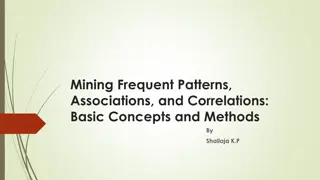Understanding Closed Patterns and Max Patterns in Data Mining
Explore the concepts of closed patterns and max patterns in data mining, along with challenges and solutions. Learn how closed patterns compress frequent patterns while maintaining support information, and how max patterns provide a lossy compression. Discover the difference between closed patterns and max patterns, and their impact on analyzing data sets.
Download Presentation

Please find below an Image/Link to download the presentation.
The content on the website is provided AS IS for your information and personal use only. It may not be sold, licensed, or shared on other websites without obtaining consent from the author. Download presentation by click this link. If you encounter any issues during the download, it is possible that the publisher has removed the file from their server.
E N D
Presentation Transcript
Closed Patterns and Max Patterns Presented by: Atefeh Rahimi Hadiseh Mohammdi Bahareh Hajihashemi Adviser: Dr. Vahidipour 1
Challenge: There Are Too Many Frequent patterns! Challenge: There Are Too Many Frequent patterns! A long pattern contains a combinatorial number of sub-patterns How many frequent itemsets does the following ???1contain? ???1?1: ?1, ,?50; ?2: ?1, ,?100 Assuming(absolute) minsup=1 Let s have a try 1-itemsets: ?1:2, a2:2, , a50:2, a51:1, , a100:1, 2-itemsets: ?1,?2:2, , ?1,?50:2, ?1,?51:1 , , ?99,?100:1, , , , 99-itemsets: ?1,?2, ,?99:1, , ?2,?3, ,?100:1 100-itemset:{?1,?2, ,?100}:1 In total:100 1 2 100 A too huge set for Any computer to compute or store! + +100 +100 = 2100 1 ??????????? 2
Solutions Closed patterns Max patterns 3
Expressing Patterns in Compressed Form: Closed Patterns Expressing Patterns in Compressed Form: Closed Patterns How to handle such a challenge? Solution 1: Closed patterns: A Pattern(itemset)X is closed if X is frequent, and there exists no super-pattern Y X, with the same support as X. Let Transaction DB ???1: ?1: ?1, ,?50; ?2: ?1, ,?100 Suppose minsup = 1. How many closed patterns does ???1contain? Two: ?1:" ?1, ,?50:2 ; ?2:" ?1, ,?100:1 Closed pattern is a lossless compression of frequent patterns. Reduces the # of patterns but does lose the support information! You will still be able to say: ?2, ,?40:2 , ?5,?51:1 4
Expressing Patterns in Compressed Form: Max Expressing Patterns in Compressed Form: Max- -Patterns Patterns Solution 2: Max-patterns: A pattern X is a max-pattern if X is frequent and there exists no frequent super-pattern Y X. Difference from close-patterns? Do not care the real support of sub-patterns of a max-pattern. Let Transaction DB ???1?1: ?1, ,?50; ?2: ?1, ,?100 Suppose minsup= 1. How many max-patterns does ???1 contain? One: ?1,?2,?3, ,?100:1 Max-pattern is a lossy compression! We only Know (?1, ,?40) is frequent. But we do not know the real support of (?1, ,?40), ,any more! 5
Difference between Closed patterns and Max patterns In the case of closed patterns by adding one item, support is decreased it means possibility of a purchase or an order will be decreased but in the case of maximal patterns adding an item will not only decrease support, but also convert that order from a common order to a particular order. 6
Example Example Frequent itemsets {A},{C},{E},{A,D} are closed frequent itemsets {C},{E},{A,D} are maximal. {A} is not maximal. TID Items in the transactions {A}:3 {C,D}:1 T1 {A,B,C,D} {B}:1 {C,E}:1 {C}:2 {A,B,C}:1 T2 {A,D} {D}:2 {A,B,D}:1 T3 {A,E} {E}:2 {A,B,E}:0 T4 {C,E} {A,B}:1 {B,C,D}:1 {A,C}:1 {B,C,E}:0 {A} is closed because none of its supersets have the same support as itself But {A} is not maximal because {A,D} is superset of {A} and is frequent Why {D} is not closed? {A,D}:2 {C,D,E}:0 {A,E}:1 {A,B,C,D}:1 {B,C}:1 {A,B,C,E}:0 {B,D}:1 {B,C,D,E}:0 {B,E}:0 {A,C,D,E}:0 {A,B,C,D,E}:0 {A,B,D,E}:0 7
Algorithm for mining max, closed sequential patterns Algorithm for mining max, closed sequential patterns 8
What do you infer from this? What do you infer from this? All maximal frequent itemsets are closed frequent itemsets but the converse is not true. Frequent itemsets Closed frequent itemsets Maximal frequent itemsets 9
Thank You 10























